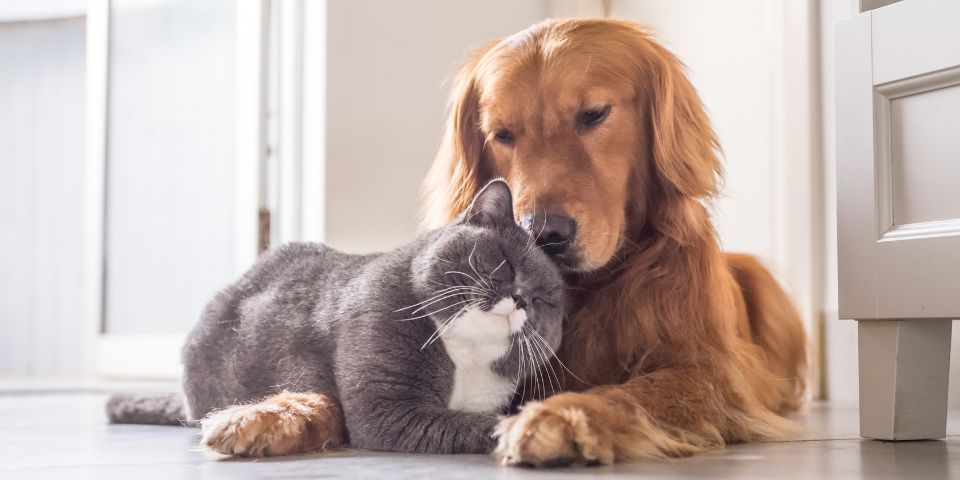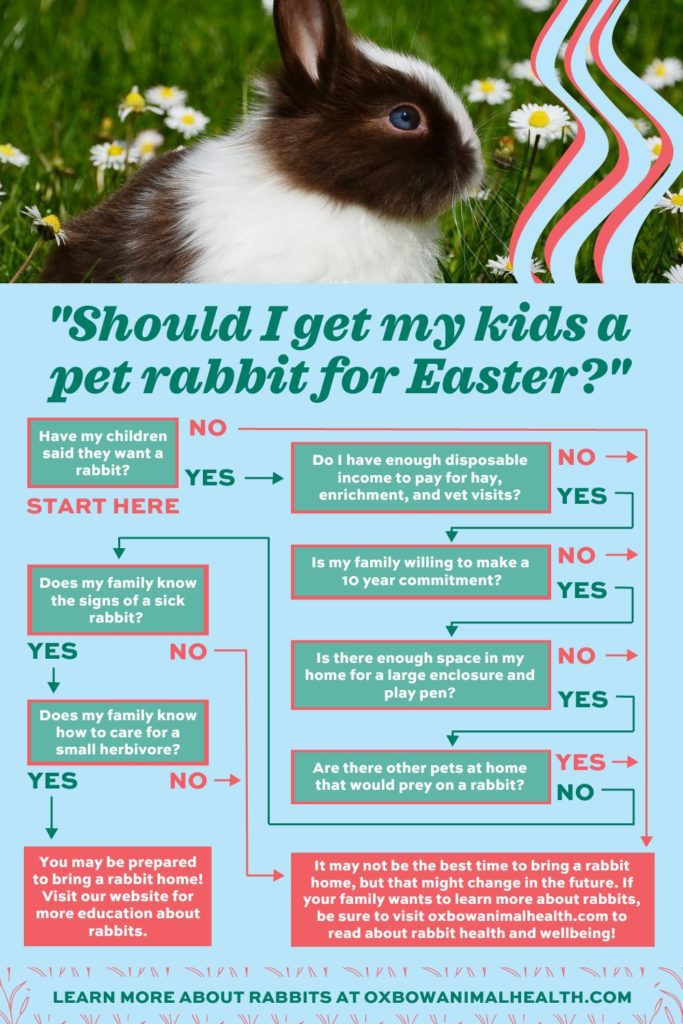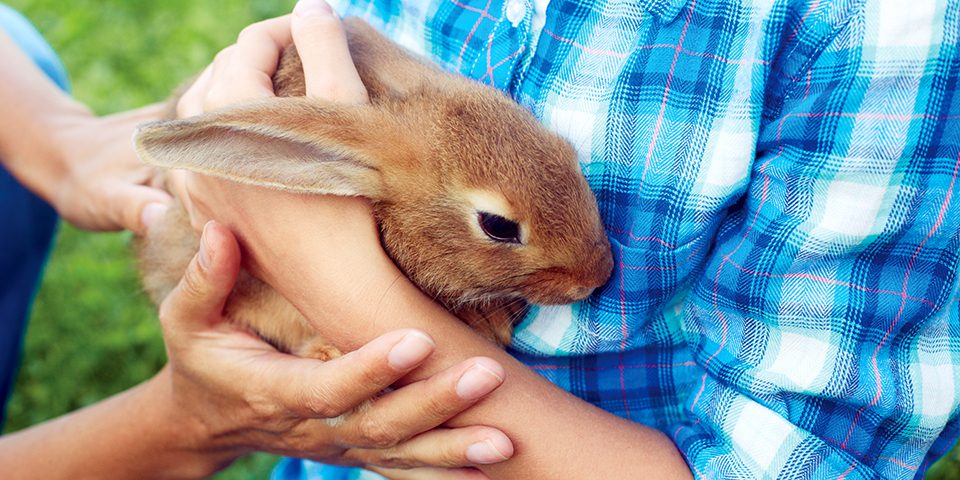Author: Kellie Hayden
Updated: March 26, 2024
We get it—it’s Easter. You’re seeing images of cute animals everywhere! After being bombarded with pictures of baby bunnies for weeks on end, it’s only natural that you’d be tempted to bring home a cute, fluffy bunny to be a family pet. While it may be easy to bring home a small pet, rabbits require and deserve a lot of careful forethought due to their unique dietary and behavioral needs.
In this blog post, we’ll cover some important considerations for your family to make before bringing a rabbit or other small animal home. Questions we’ll encourage you to answer include:
- Do my children know how to properly feed and care for a rabbit?
- Where will a rabbit safely live in my home?
- Is there enough space inside the home to properly support a rabbit?
- Who will pay for the rabbit’s long-term care?
- What will the members of my household be doing in ten years?
- Are there other pets in the household that might prey on a small pet?
- Are my children mature enough to notice when something’s wrong with an animal?
- Do my children even want a rabbit as a pet?
We hope that by the end of this blog, you’ll have a clearer idea of the commitment to care that small animals require—and the rewards that come with this commitment, too!
Is it Okay to Surprise my Kids with a Pet Rabbit?
The idea of surprising a loved one with a pet was once a common practice for birthdays or significant holidays, and in some regions is still common. Gifting pets isn’t unique to small animals, either; it’s frequently a plot point in movies and other pop culture to gift a dog or cat, normalizing this gift-giving behavior.
Today, more people are rightfully applying a critical lens to this practice. Exotic animals such as rabbits and guinea pigs require specialized care—an extent of care that some people who are gifted these animals are not fully aware of, and sometimes not prepared to give.
Especially when children are expected to care for an animal, they should learn alongside you about the needs of different pets. While surprises are often fun, your family should have many conversations about the responsibilities of pet parenthood before any kind of pet is brought home.

Do my children know how to properly feed and care for a rabbit?
The first question you should be asking is whether or not the person who is receiving this animal knows what to feed this pet. Do they know whether this animal is an herbivore, omnivore, or something else—and do they know what these important designations mean? Do they understand why pets need access to high-quality food daily? If they don’t know the answers to these questions, are they willing to learn and make necessary improvements to their pet’s diet?
Where will a rabbit live in my home?
While it used to be common for rabbits and guinea pigs to live outdoors in unsupervised hutches, this practice is becoming less and less common as people realize what wonderful house pets these unique species make.
Exotic animals haven’t been domesticated for thousands of years like cats and dogs, so they will tend to behave more in line with their hard-wired instincts. That being said, small animals like rabbits and guinea pigs (which have been domesticated for at least a few hundred years) will generally still want to socialize with their human family. They can’t do this when they’re outdoors all the time!
Just like a cat or dog, small animals like rabbits need to have a central place in the home where they can regularly observe and interact with their family members.
Is there enough space inside my home to properly support a rabbit?
Caring for small pets is not as simple as it once was perceived to be. We’ve learned that small enclosures offering only about a square foot or two of space is simply not enough room for a rabbit or guinea pig. Consider that an enclosure is not only just a living space for an animal: it is their living space, sleeping space, exercise space, and even bathroom. Because an enclosure acts as all of these things, guinea pigs and rabbits need enough room for all of these activities while still living in a clean hygienic space. Enclosures that can be placed on a desk or dresser can’t provide enough room for a guinea pig or rabbit to thrive.
In addition to providing enough room within an enclosure, small animals also need time outside of the habitat! Oxbow recommends that small animals have at least one hour of time outside of their habitats daily to explore a pet-proofed space.
Who will pay for the rabbit’s long-term care?
Can the person who’s being gifted this animal afford the food, shelter, and veterinary bills that are necessary to keep this animal happy and healthy? Anyone who’s impulsively purchased an animal can attest: exotic animals may be small, but that doesn’t mean the long-term costs of keeping them will be!
Rabbit and guinea pig owners tend to find that between food, enrichment, and vet care, they spend more money per month than the average dog or cat owner. If the person you’re considering giving a new pet to doesn’t have enough disposable income to care for an animal, that’s a big sign they should be gifted chocolate, flowers, or a plushie instead.
What will the members of my household be doing in ten years?
If a decade seems like a surprising amount of time to factor in, know that this is the average lifespan for a rabbit. While some rabbits may not live ten years, others can live well beyond ten. If you’re considering getting your 16-year-old a rabbit, are they going to take the rabbit with them when they go to college in two years (this answer may be “no” regardless of if your child wants to or not—many campuses do not allow pets in dorms!)?
We understand that the future can be hard to predict, but an animal may not factor in what someone may have planned for the next decade of their life. Some paths cannot feasibly fit pet care in. Thinking about this ahead of time can prevent your family from needing to surrender an animal in the near future.

Are there other pets in the household that might prey on a rabbit?
Yes, there are some cats or dogs out there that do perfectly fine with multiple species in the house. This should be considered out of the ordinary, however, and not be considered normal. Much like how prey species are wired to run and hide at even the hint of predators, predatory species like cats and dogs are wired to investigate and chase objects that act like the animals they would hunt in the wild. If you already have animals in the house, you’ll need to carefully consider how all pets are going to be kept safe and happy when living under the same roof. For more info, check out our tips for becoming a multi-species household.
Are my children mature enough to notice when something’s wrong with a rabbit?
Rabbits and other prey species are masters at hiding illness. In the wild, their ancestors evolved the behavior of masking any illness or injury. This behavior helped prevent predators from easily picking them off from the group and targeting them for a meal. Since this behavior benefitted these prey species and kept them alive long enough to reproduce, this behavior was passed on for many generations and became a hard-wired instinct.
While masking illness served rabbits and guinea pigs in the wild, in domesticated situations they will still mask illness even when the threat of predation has been removed. This means that these animals will mask illness until they’re so sick they can no longer hide it. As a result, pet parents may not reach out to veterinarians until the illness is visible and their rabbit is very sick. Whoever is caring for a pet needs to be well-attuned to the species’ particular behaviors and needs to always be watching for subtle changes in habits such as eating, mood, or activity levels.
Do my children even want a rabbit as a pet?
You’d be surprised at how much the desire for a pet is a foregone conclusion! Before getting serious about bringing an animal home as a surprise, it’s incredibly important to make sure that all parties involved want a pet, and that all agree to sharing in the responsibilities of feeding, cleaning and interacting with this new pet.
A handful of readers may find that they’ve answered all of these questions mindfully, and the person to who they’re gifting an animal seems ready for the commitment of a pet. That’s wonderful! Other readers might find that they do not yet have clear answers to all of these questions. That’s perfectly okay, but it is a sign that it may be best to delay getting a small pet as a gift or to plan on giving an alternative gift. Wherever you landed, we hope this article has provided you with the insight needed before adding a new animal to your family.



